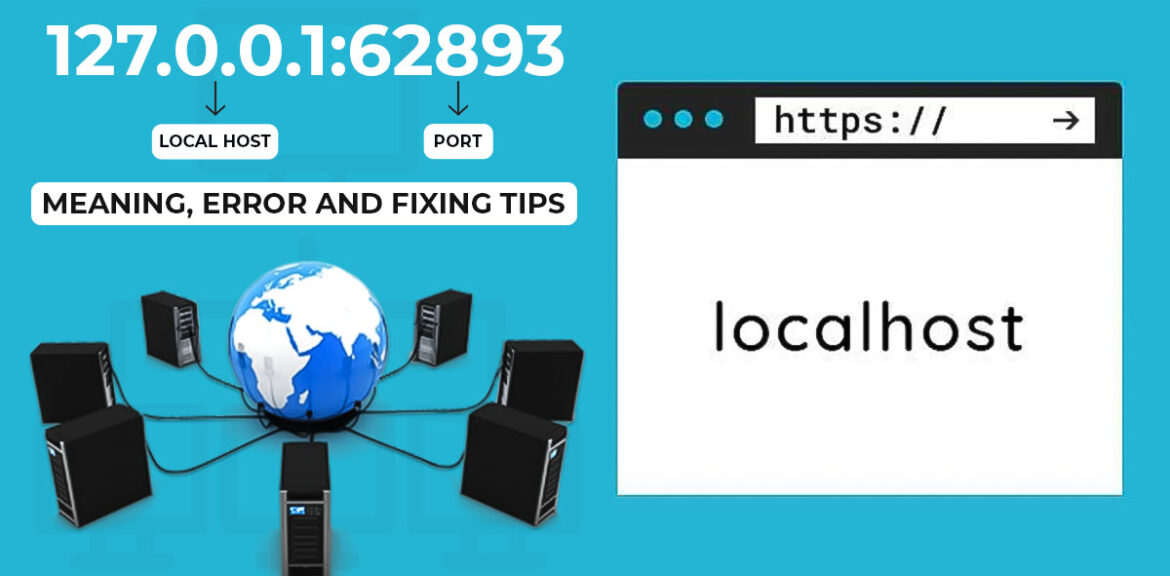127.0.0.1:62893 – Meaning, Errors, and Solutions
If you’ve encountered the code 127.0.0.1:62893 while working on your computer, you may have found it perplexing. Whether it’s tied to an error message like “Disconnected from the target VM, address: 127.0.0.1:62893,” or you’re simply trying to understand its purpose, breaking down its meaning can provide valuable insight, especially for developers. In this post, we’ll demystify what this code means, how it functions, and provide troubleshooting tips if you run into common errors.
What Does 127.0.0.1:62893 Mean?
This address is composed of two essential elements:
- 127.0.0.1: Commonly known as “localhost,” this is a loopback IP address used to refer to your own computer. Think of it as your machine’s internal address when it needs to communicate with itself. It’s commonly used in networking and development environments for testing purposes.
- 62893: This is a port number. Ports serve as virtual “doorways” that allow specific applications or services to send and receive data. While port 62893 is less frequently used than others, it sometimes comes into play when running services like Memcached, a caching system often used in web applications.
Benefits of Using 127.0.0.1:62893
Understanding and utilizing this address can provide several advantages, particularly in development:
- Development and Testing: Developers frequently use
127.0.0.1to create a local, isolated environment for testing applications. This setup ensures that no external factors interfere during testing. - Networking Concepts: Localhost is integral to learning and implementing networking protocols, such as TCP/IP and client-server communication.
- Security: Monitoring localhost and specific ports like 62893 helps identify any suspicious activity on your system, providing an additional layer of security.
- Debugging: Localhost is often used to troubleshoot and pinpoint issues within a networked application, making debugging easier.
- Isolated Development: Using
127.0.0.1prevents conflicts with other applications on your system, as the communication stays contained within your own device.
How 127.0.0.1:62893 Works
Here’s a simplified view of how this combination operates:
- An application running on your device needs to communicate with another process or service.
- It specifies
127.0.0.1(localhost) as the destination, meaning it’s targeting something on the same machine. - The port number (62893) tells the system which specific program or service should handle this communication.
For example, a development tool such as a debugger might use this address to connect to a local server running on your machine, enabling developers to test and troubleshoot applications without needing an external server.
Is It Safe to Expose Port 62893 Publicly?
Exposing port 62893 (or any localhost port) to the public internet is not advisable. Here’s why:
- Security Exploits: If a vulnerable service like Memcached is running on port 62893, malicious users could exploit it to gain unauthorized access to your system.
- Denial-of-Service (DoS) Attacks: Hackers can target exposed ports with DoS attacks, potentially crashing your system.
- Unauthorized Access: Allowing public access to port 62893 increases the risk of outside attackers connecting to services like Memcached, which could lead to data breaches.
Common Error: “Disconnected from the Target VM, Address: 127.0.0.1:62893”
If you’re working with development tools like Visual Studio Code (VS Code) and encounter the error “Disconnected from the target VM, address: 127.0.0.1:62893”, it usually means that the debugger couldn’t connect to the target machine or service. Here’s how to resolve it:
Fixing Steps:
- Ensure the Service is Running: Verify that the service or application you’re trying to connect to is running properly on your machine.
- Verify Port Configuration: Double-check the port number in your configuration. Ensure that the service is actually using port 62893.
- Firewall Settings: Sometimes, your firewall may block access to local ports. Ensure that your firewall allows connections on port 62893 for localhost.
- Restart the Service: If the service or application has crashed, restart it using the appropriate commands.
- Change Port Number: If another service is using port 62893, you can modify the port number in your application settings to avoid conflicts.
- Configure Firewall Rules:
- On Windows: Go to Control Panel > System and Security > Windows Defender Firewall > Advanced Settings > Inbound Rules. Create a new rule for port 62893 to allow local traffic.
- On Mac/Linux: Use terminal commands like
iptablesto add an exception for port 62893.
- Check for Existing Usage: Use tools like
netstat(Windows) orlsof(Linux/Unix) to check if another application is already using port 62893.
Still Facing Issues?
If the error persists after trying these solutions, it might be time to consult the software’s documentation or seek help from a developer. Alternatively, you can reach out to an IT service provider like Orage Technologies for expert assistance.
The Soulfeed offers a range of services that can help resolve issues like “Disconnected from the target VM” and more:
- Application Development: Expert teams can quickly resolve common development issues like port conflicts.
- Website Design and Development: Build secure, error-free websites with the help of professional developers.
- Cloud Solutions: Streamline your data management with reliable cloud services.
- Cyber Security: Ensure your systems are secure by consulting experts in cybersecurity.
Conclusion
While 127.0.0.1:62893 may seem like a cryptic code, it represents a key concept in networking and development. The localhost IP address (127.0.0.1) ensures secure, internal communication, and the port number (62893) specifies a unique service or process. By understanding how this address works and knowing how to troubleshoot related errors, you can create a more efficient and secure development environment.
Related Reading:
By breaking down technical issues like this, you can better understand your tools, work more efficiently, and keep your system secure.







